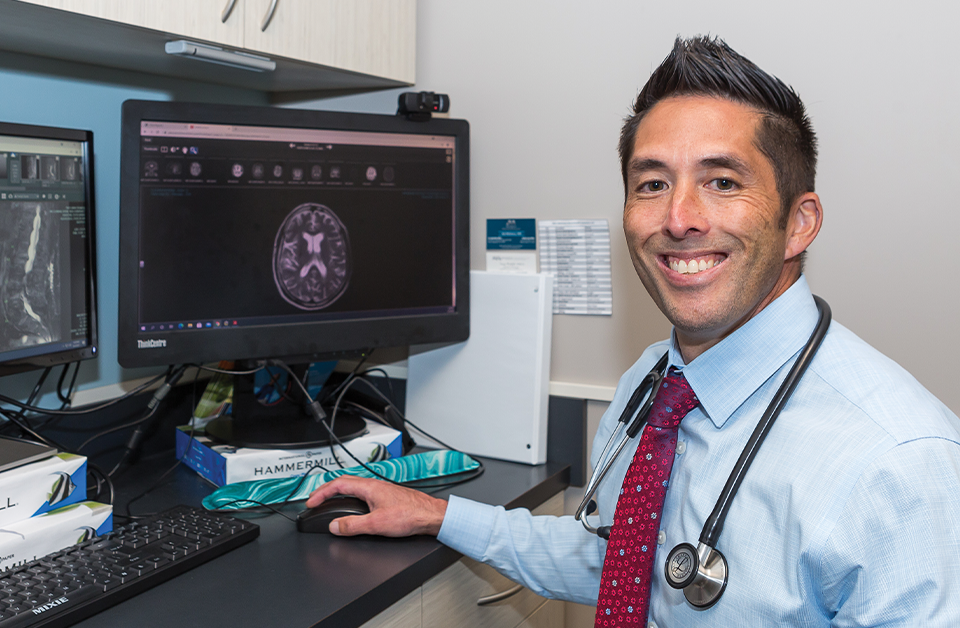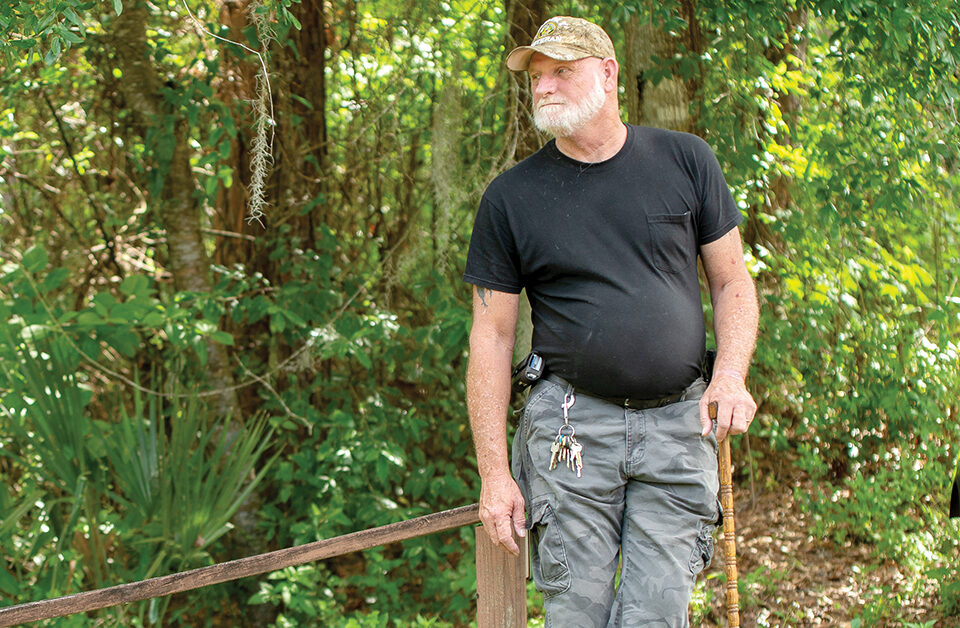

Board-certified neurologist and pain management specialist Kai McGreevy, MD, founded McGreevy NeuroHealth in 2015 in an effort to deliver patients from the pain and discomfort that keeps them from fully participating in life.
With offices in St. Augustine and Palm Coast, Dr. McGreevy uses his expertise to create winning game plans that address his patients’ most pressing issues, most of which are related to neurologic conditions and pain disorders.
“Patients generally come to us for treatment of an acute injury or chronic problem,” Dr. McGreevy observes. “The treatment we deliver may be a cure, or it may be palliative to provide a better quality of life. In every case, our goal is to reduce or eliminate pain and suffering.”
McGreevy NeuroHealth stands apart from other neurology and pain management centers because it doesn’t focus solely on the patient’s presenting complaint. Instead, Dr. McGreevy assesses the patient’s entire health history. This emphasis is central to Dr. McGreevy’s neurohealth philosophy.
“Neurohealth is the viewpoint of the patient as a whole rather than a specific system or organ,” Dr. McGreevy elaborates. “In the field of medicine today, physicians often get locked into their specialties and concentrate only on their niche areas. They can sometimes lose sight of how the body’s various systems are interconnected.”
Dr. McGreevy’s neurohealth philosophy appreciates this integration. He begins with a thorough knowledge of the nervous system, then dives deeper and examines how the nervous system relates to the rest of the body. Understanding the complete picture drives Dr. McGreevy’s choice of treatment for his patients.
“The nervous system is a complex and far-reaching network of specialized cells,” Dr. McGreevy enlightens. “It includes everything associated with the brain and mental health. It also includes the spinal cord and peripheral nerves, which run all the way down to the feet.
“As we learn more and better understand the nervous system, we realize that there’s significant interplay between it and other systems in the body.”
An example is the vascular system, which involves blood vessels running throughout the body. The nervous system depends on an adequate passage of blood from those vessels to thrive, the doctor points out.
“Specialists evaluating patients for neurologic diseases or pain disorders must understand the interplay of these systems to achieve the highest likelihood that their treatments will benefit the patient,” he continues.
Dr. McGreevy takes the relationship between neighboring body systems into account when evaluating patients under his neurohealth philosophy. But the neurologist wants to know even more, so he’s furthering his education to enhance his expertise.


The nervous system includes nerves that run from the brain to the feet. As a result, Dr. McGreevy addresses problems from head to toe.
“I’ve been building the neurohealth philosophy at McGreevy NeuroHealth for several years,” Dr. McGreevy relates. “And I’ve been extending my academics to better appreciate the interplay of systems and how it affects neurologic and pain disorders.”
To that end, Dr. McGreevy has added several subspecialty certifications to his resumé. In addition to his certification in neurology and pain management from the American Board of Psychiatry and Neurology, Dr. McGreevy has earned certification in headache medicine, brain injury medicine and neuroimaging from the United Council for Neurologic Subspecialties.
“In learning more about these subspecialties, I gained a more comprehensive understanding of how the nervous system works and how it malfunctions,” Dr. McGreevy discloses. “Now, I better comprehend the mechanisms and pathology of neurologic disorders so I can target my treatment. These certifications enhance patient care at McGreevy NeuroHealth.”
To determine what’s wrong with the nervous system, physicians often must take a closer look at it through imaging modalities such as MRI, CT, PET scans and ultrasound. This is where Dr. McGreevy’s neuroimaging certification is especially valuable. By completing the additional education, he developed expertise in interpreting images.
“The neurologist’s clinical examination identifies the specific details of the imaging study,” Dr. McGreevy asserts. “The clinician asking the questions knows exactly what to look for, so his interpretation of the images is more accurate. When sending the images out for interpretation what the neurologist is seeking can get lost in translation.
“The goal behind my earning these subspecialty certifications is to make patient care at McGreevy NeuroHealth more cohesive, to provide a continuous flow of information that ultimately benefits the patient.
“Neuroimaging is my newest certification. It is another example of how I am further developing our neurohealth philosophy. It also represents the direction McGreevy NeuroHealth is headed in the future.”
Done in Six Sections
Dr. McGreevy determines which, if any, imaging tests are necessary once he completes a review of the patient’s history and performs a complete neurologic examination.
“The questions we ask the patient prior to the neurologic examination drive the exam,” Dr. McGreevy contends. “Using the patient’s history, we try to identify a pattern to the symptoms that correlates to a specific disorder. Then, we look for more answers in the neurologic exam, which typically tells us if imaging is needed.”
The neurologic exam is an exhaustive evaluation consisting of six sections. The first is the mental status exam. During this section, Dr. McGreevy performs various bedside tests to glean information about functions such as learning and memory, attention and concentration, language, speech and executive functioning.
“After the mental status exam, we proceed to the cranial nerve exam, which is broken down into 12 parts for the 12 cranial nerves,” Dr. McGreevy informs. “The cranial nerves are responsible for multiple functions including vision and eye movement, balance and coordination, taste and smell.”
Next is the motor exam, where Dr. McGreevy tests the nerves involved with muscle movement. Weakness in a particular muscle or muscle group, a limb or one side of the body gives Dr. McGreevy a clue about the patient’s condition.
He then moves on to the sensory exam.
“Patterns of sensory loss tell us a lot about the location of the patient’s disorder,” Dr. McGreevy educates. “For instance, if the patient experiences a pattern of sensory involvement where one side of the body feels numb, there’s likely a problem in the deeper part of the brain known as the thalamus.”
Next, Dr. McGreevy tests deep tendon reflexes. Reflexes that are absent indicate certain types of dysfunction, while hyperactive reflexes are suggestive of other disorders. This part of the exam helps the neurologist localize the patient’s issue, whether it’s related to the peripheral nerves, the spinal cord, or the brain.
“The last section of the neurologic exam evaluates coordination and gait,” Dr. McGreevy reveals. “We test coordination with exercises such as finger-to-nose and rapid alternating movements. Gait testing is an evaluation of the patient’s stride and walking. There are many clues about pathology found by examining the gait.”
Sometimes, the history and neurologic exam give the neurologist clear answers about the patient’s condition. In those instances, imaging may not be necessary to make a diagnosis.
“That’s not always the case, however,” Dr. McGreevy emphasizes. “There are times when the neurologic exam provides confusing or conflicting information that doesn’t correlate to the patient’s symptoms, or we discover something that the patient didn’t report. With this uncertainty, we rely on diagnostic testing to help us decipher what’s going on. Neuroimaging, in particular, is a big piece of that diagnostic picture.”
Planned Expansion
McGreevy NeuroHealth offers comprehensive x-ray and ultrasound testing and interpretation, and plans are underway to add a complete MRI suite.
“Our goal is to have a full neuroimaging center to support our clinical neurology center,” the neurologist elaborates. “Neuroimaging will advance our pain management goals as well. Many of the spine-related conditions we treat involve fractures, disc herniations, nerve root impingement and arthritis. These conditions can be more accurately evaluated using MRI.

“Having MRI on site will be very fruitful. Our patients will then receive a thorough neurologic history, examination and imaging in one location. That will result in an accurate answer to the patient’s problem and will drive management much faster.”
Ultrasound Opportunities
The nervous system includes nerves that run from the brain to the feet, so McGreevy NeuroHealth addresses problems from head to toe. To identify the cause of these problems and better direct treatment, Dr. McGreevy often employs targeted ultrasound.
“Often, we automatically attribute back and limb pain to the spine, but that’s not always true,” Dr. McGreevy insists. “We implement musculoskeletal ultrasound to seek out mimickers of spine and extremity pain, including injuries to joints, muscles, tendons, ligaments and peripheral nerves. Many times, pain is referred from these structures or may compound spinal pain problems.”
Musculoskeletal ultrasound also enables Dr. McGreevy to see how body parts such as joints, muscles, tendons and ligaments work in a dynamic fashion.
“Ultrasound is unique to MRI and CT for this purpose because MRI and CT are static images,” Dr. McGreevy notes. “With ultrasound, we can take high-resolution, moving images while the patient is performing a physical maneuver such as flexing the joint. This allows us to visualize mechanical problems with the joint or soft tissues.
“The beauty of musculoskeletal ultrasound is that I can actually see the potential problem in real time. The problem may be a nerve entrapment or adherence of a nerve to a specific structure, as in carpal tunnel syndrome. I can also identify a degenerated rotator cuff in the shoulder or meniscus in the knee causing chronic pain.
“The problem may be an underlying rheumatologic disorder such as rheumatoid arthritis or lupus creating joint swelling or inflammatory fluid not due to wear and tear. Having the overall neurohealth concept allows us to catch systemic conditions and sometimes leads us to the identification of downstream pain or neurologic problems.”
Problems with the vascular system can also be pinpointed using ultrasound.
“Identification of vascular diseases is critical because vascular conditions often present acutely and may lead to serious life-threatening or limb-threatening problems,” Dr. McGreevy stresses. “Pain is often the presenting symptom. Therefore, pain physicians should be equipped to identify vascular conditions early and manage them aggressively.
“We use vascular ultrasound to seek out causes for leg pain such as peripheral artery disease (PAD), blood clots or venous insufficiency that can mimic spine and nerve problems. Sometimes, we employ leading-edge laser and radiofrequency vein ablation treatments to ameliorate leg pain, discomfort, swelling, heaviness, fatigue and cramping.”
Ultrasound also allows Dr. McGreevy to investigate the carotid arteries and blood pathways leading to the brain. Sometimes, he discovers disease early to protect against stroke and conditions that develop later in life such as vascular dementia.
When vascular disease in the head is diagnosed early, preventive measures can be instituted that help maintain brain health and even prolong life. These measures may include lifestyle changes, medications or surgery.
Complementary Testing
McGreevy NeuroHealth may use complementary tests to assist in making a diagnosis. These include electromyography, or EMG, and nerve conduction studies to evaluate large fiber nerve problems and spinal nerve root issues. They also help localize sources of pain, numbness, tingling and weakness.
“We also use autonomic nervous system testing for detecting disease involving small nerve fibers and vessels,” Dr. McGreevy reports. “These problems can be seen with autonomic disorders not readily assessed by EMG or ultrasound, warranting specific treatment.”
Electroencephalography, or EEG, allows Dr. McGreevy to evaluate brain function to understand the brain’s susceptibility to epilepsy and other seizure disorders presenting as spells involving memory lapses, blank staring, speech arrest, vertigo and confusional states. Sometimes these symptoms are subtle, and an interruption of signals is the underlying cause.
“We follow a big-picture approach, which allows for targeted, effective treatments that are efficient and improve outcomes.” – Dr. McGreevy
“The eVox is particularly useful in patients with cognitive complaints in association with headache, traumatic brain injury (TBI), mild cognitive impairment, memory disorders, attention deficit disorder, depression, anxiety, and stress and pain conditions,” Dr. McGreevy states. “We know that cognitive problems occur in neurologic and psychiatric conditions such as stroke, multiple sclerosis, Parkinson’s disease and epilepsy.”
Easing stress and anxiety profoundly reduces the experience of pain. Addressing these components are crucial for overall management of the problem. Identification of regions of interest that are firing abnormally may be targeted for correction through a noninvasive treatment such as EEG neurofeedback, which is available at McGreevy NeuroHealth.
“With EEG neurofeedback, the patient can be taught brain-training approaches, akin to physical therapy for the brain,” Dr. McGreevy describes.
Dr. McGreevy spends a significant amount of time establishing a diagnosis to understand the patient’s pain condition and determine the most targeted treatment. The neurologist uses all treatments available within the practice of interventional pain management including fluoroscopic-guided facet blocks, epidural steroid injections, radiofrequency ablation, spinal cord stimulation and kyphoplasty.
As the field of pain management expands, Dr. McGreevy also offers advanced therapies including peripheral nerve stimulation for nerve entrapment and neuropathic pain syndromes.
Regenerative Treatments
“In addition to these interventions, we also have regenerative treatments specific to failing joints, tendons, ligaments and soft tissues,” Dr. McGreevy acknowledges. “Often, patients do not need surgery to fix shoulder, knee, foot or ankle problems, or conditions such as carpal tunnel syndrome. Sometimes, I can perform minimally invasive injection treatments under ultrasound guidance instead.
“Sometimes, the intervention uses hydrodissection to free up a nerve from entrapment by a scarred muscle or tough bands of tissue. Degenerating tendons may be treated with treatments such as tenotomy, fenestration or by other regenerative means. Here we stimulate the body’s natural immune responses to produce growth factors for repair and healing. This is helpful for syndromes such as rotator cuff problems, tennis elbow or knee meniscus symptoms.”
On rare occasions, the use of musculoskeletal ultrasound allows for identification of masses suspicious for cancer that may be causing pain, and early identification may lead to surgical correction. With ultrasound, Dr.McGreevy can see all the structures in the extremities, including blood vessels, nerves, muscles, tendons, ligaments and
bone surfaces.
“Using ultrasound, I can direct the needle to within a millimeter of the structure I am approaching,” Dr.McGreevy divulges. “That cannot be done with MRI or CT. Not only is that not feasible with those modalities, those tests are much more expensive to use.
“We follow a big-picture approach, which allows for targeted, effective treatments that are efficient and improve outcomes. And we are doing this in a manner that takes advantage of the sophisticated diagnostics available. This approach also enables us to cut down on health care costs.
“That big-picture approach is best defined by our neurohealth philosophy. Through that philosophy, we combine the benefits of neurology and pain management with musculoskeletal medicine, vascular medicine and mental health care to optimize our ability to help patients.”












Leave a Reply